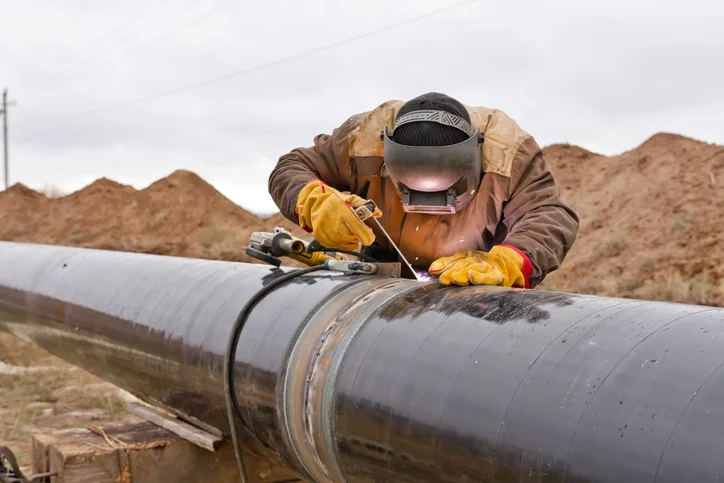Precision Issues: Relied On Pipeline Welding Inspection Services for Critical Tasks
Precision Issues: Relied On Pipeline Welding Inspection Services for Critical Tasks
Blog Article
Important Pipeline Welding Examination Tips for Quality Control
In the realm of pipe building and construction, the stability of welds holds paramount value to guarantee the safety and security and efficiency of the whole system. From all-natural gas to improved petroleum items, pipelines form the lifeline of numerous industries. However exactly how can one guarantee the quality of these welds that connect the pipe areas? The response lies in meticulous examination strategies and adherence to rigid quality guarantee standards. By understanding the essential pipe welding assessment tips, specialists can prevent potential threats, minimize pricey repair services, and maintain the integrity of these critical facilities.

Importance of Welding Examination
Welding evaluation plays an essential duty in guaranteeing the architectural integrity and safety and security of pipeline systems. By diligently analyzing welds, assessors can identify any type of defects or flaws that might endanger the integrity of the pipe. These inspections are necessary for preventing leaks, tears, and various other potentially disastrous failings that could lead to environmental damage, monetary losses, and also loss of life.
The significance of welding examination can not be overstated, as the high quality of welds straight influences the overall performance and longevity of the pipeline. Via non-destructive screening methods such as visual assessment, ultrasonic screening, radiography, and magnetic fragment testing, inspectors can discover imperfections that may not be visible to the naked eye. By determining and resolving these concerns at an early stage, welding evaluation assists to make sure that pipes fulfill sector standards and regulatory requirements.
Eventually, welding evaluation is a vital facet of top quality guarantee in pipe repair service, building, and maintenance (Pipeline Welding Inspection). By promoting strenuous evaluation requirements, industry professionals can mitigate threats and maintain the security and dependability of pipeline systems
Usual Welding Flaws
Among the obstacles faced in pipeline welding, typical issues can considerably affect the architectural honesty and performance of the bonded joints. Cracks in the weld can propagate over time, jeopardizing the architectural honesty of the pipeline. Discovering and resolving these usual defects through complete examination and quality control processes are vital for making sure the integrity and safety and security of pipeline welds.
Inspection Techniques for Pipelines


Non-destructive testing (NDT) strategies such as radiographic testing, ultrasonic screening, magnetic particle testing, and fluid penetrant testing are frequently utilized in pipe welding inspection. Aesthetic inspection is likewise essential in pipe welding to recognize any noticeable defects or stoppages. Additionally, automated inspection strategies using advanced innovations like drones and robotics are increasingly look at these guys being utilized to boost the efficiency and accuracy of pipe evaluations.
Making Certain Quality Control Requirements
To maintain rigid quality control criteria in pipeline building and construction, careful adherence to established sector procedures and standards is imperative. Quality guarantee in welding processes calls for an extensive strategy including numerous phases of pipeline building and construction. Making sure the quality of welds includes making use of qualified welders, correct welding procedures, and adherence to sector standards such as those established by the American Petroleum Institute (API) and the American Culture of Mechanical Engineers (ASME) Assessment and testing play a crucial duty in confirming the honesty of welds, with techniques like non-destructive testing (NDT) being critical for discovering possible problems. In addition, keeping detailed paperwork throughout the welding procedure is important for traceability and high quality control objectives. Implementing a robust high quality monitoring system that includes regular audits and evaluations can better enhance the overall high quality assurance standards in pipeline welding. By focusing on adherence to these criteria, stakeholders can make certain the reliability and safety of pipeline systems for the long-term.
Avoiding Costly Repairs
Offered the critical significance of preserving rigid top quality guarantee standards in pipeline construction, a positive technique to protecting against costly repair work is vital. Routine upkeep checks and tracking of ecological variables that can influence the honesty of the pipe are additionally critical in protecting against pricey fixings. By investing in preventative steps and prioritizing quality assurance at every phase of the pipe welding procedure, business can lessen the danger of costly repair work and guarantee the long-term reliability of their framework.
Final Thought
To conclude, adherence to appropriate welding evaluation techniques is essential for ensuring the top quality and honesty of pipelines. By identifying usual welding issues and carrying out extensive evaluation processes, expensive fixings can be protected against, view website and quality control requirements can be fulfilled - Pipeline Welding Inspection. It is important for pipe welders to prioritize examination procedures to maintain the security and integrity of the framework they are dealing with
The significance of welding examination can not be overstated, as the high quality of welds straight impacts the total performance and longevity of the pipe. Non-destructive testing see page (NDT) methods such as radiographic screening, ultrasonic screening, magnetic bit testing, and fluid penetrant screening are commonly utilized in pipeline welding evaluation. Visual evaluation is additionally crucial in pipe welding to identify any visible issues or suspensions. In addition, automatic evaluation strategies making use of innovative innovations like drones and robotics are significantly being employed to boost the efficiency and accuracy of pipe examinations.In conclusion, adherence to proper welding assessment techniques is vital for making certain the high quality and integrity of pipes.
Report this page